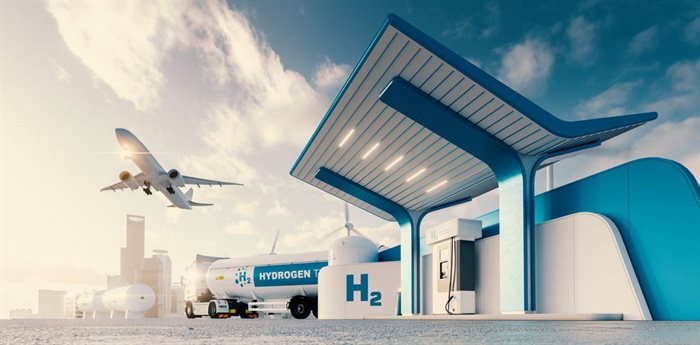This potential route to wide-scale decarbonisation is nearing realisation thanks to rising investment in the field as well as the collaborative partnerships being penned by both public and private sector players.
Collaboration driving the hydrogen economy
The Presidency, for instance, earlier this year announced its collaborative partnership with the German Federal Ministry of Economic Cooperation and Development to promote the green hydrogen economy in South Africa. The German ministry has pledged support of at least €12.5m in funding.
Then there's the Investment and Infrastructure Office in The Presidency which has itself pledged support of a project led by Sasol and Germany's H2Global green hydrogen initiative - a partnership that aims to produce sustainable aviation fuel for the international market.
Sasol, late last year, also signed an agreement with the Northern Cape government to conduct a two-year feasibility study for a green hydrogen project in the province's Boegoebaai which could see the province producing at least 400 kilo-tonnes of hydrogen annually. It also signed a partnership with the Gauteng provincial government to leverage its special economic zones.
"These have been earmarked as enablers to unlock South Africa’s green hydrogen market potential for domestic use, such as mobility, revitalisation of the steel industry and sustainable aviation fuel, particularly at OR Tambo [International Airport],” said Sasol’s vice president for energy business Priscillah Mabelane at last year's Sustainable Infrastructure Development Symposium of South Africa.
Hydrogen valley gets green light
Another public-private partnership heavily investing in developing the local green hydrogen economy is among the Department of Science and Innovation (DSI), Anglo American, Engie, Sanedi, and Bambili Energy. The partnership launched the Hydrogen Valley Feasibility Study Report in October last year which has given the green light for the development of a proposed hydrogen valley that will start near Mokopane in Limpopo, where platinum group metals (PGMs) are mined, extending through the industrial and commercial corridor to Johannesburg and leading finally to Durban.
Successfully implemented in other countries to promote clean emerging technologies and their commercial viability, the ambitious local plan aims to identify tangible opportunities to build hydrogen hubs in this key economic and transport corridor, exploring the potential for hydrogen production and supply at scale.
Achieving net-zero emissions
With the climate crisis making decarbonisation an urgent imperative, the goal post has shifted from reduction to achieving net-zero carbon emissions, and to support this transition, heavy investment in renewable energy development is now underway. According to Engie's Jonathan Debasc, however, due to its lack of unpredictability, renewables' potential to get us to net-zero emissions is limited. Utilising the energy produced by renewables, he says we would be able to generate green hydrogen that can be stored and transported where needed.
Debasc was speaking at a recent Business Day Dialogues Live discussion, joined by Natascha Viljoen, CEO of Anglo American Platinum, and Fahmida Smith, market development principal at Anglo American.

L-R: Natascha Viljoen, CEO, Anglo American Platinum; Jonathan Debasc, MD: Thermal, Supply and Hydrogen Africa, Engie; Fahmida Smith, market development principal, Anglo American; and Alishia Seckam, journalist
He also noted that South Africa is in a prime position to invest in the hydrogen economy due to the ample land available on which to develop renewable energy compared to its competitors, its abundant natural wind and solar resources are among the top five countries in the world, and the country is equipped with the expert knowledge and experience needed in hydrogen production. During the recent launch of the National Hydrogen Social Roadmap, higher education, science, and innovation minister Dr Blade Nzimande also pointed out that South Africa has comparative advantage in that the country is home to 75% of the world reserves of the platinum group metals (PGMs), which are key to building renewable energy plants.
Mogalakwena hydrogen-powered haul truck project
Highlighting the role of green hydrogen in Anglo American's own decarbonisation journey, Viljoen pointed to the company's heavy duty haul trucks that, together with the ore they transport, can weigh up to 500 tonnes each, and require vast amounts of energy to keep running. Currently using diesel, Anglo is looking at green hydrogen as an alternative fuel source for its fleet that could allow it to reduce its carbon emissions by 80%.
Anglo American will this year be piloting this particular project at its Mogalakwena PGMs mine in Limpopo where it plans to build a 3.5MW electrolyser to produce hydrogen on-site for use in fuelling the hydrogen-powered fuel cell electric haul truck. It aims to thereafter roll out the technology across its Mogalakwena fleet and those at its other operations globally as the phases of the project advance.
Johannesburg-Durban freight corridor
Beyond the Mogalakwena project, excess hydrogen produced will also be used to support the development of the freight corridor between Johannesburg and Durban. "Through the corridor, we have a three-phased approach so the first phase is really looking at a few trucks and a number of buses. The second phase is 50 trucks and 50 buses, and the phases thereafter, you're looking at a couple 100 units each. Once you do that, you develop the infrastructure for refuelling, you get hydrogen generation, and closer to those points you can then roll out additional applications," explained Smith.
In addition to its own decarbonisation efforts, green hydrogen development is also key to extending the mining group's PGMs market as the minerals are core to the development of hydrogen technologies such as electrolysers and fuel cells, as well as the transport and storage of hydrogen.
Yershen Pillay 20 Oct 2021
Economic development and job creation
The global hydrogen market is expected to record a value of $184.10bn in 2025, and in reaching scale in the local market by 2050, the green hydrogen economy has the potential to create a minimum of 14,000 much-needed jobs per annum.
However, it is vital that we invest in an appropriately skilled workforce to fulfill the new roles created by the hydrogen economy, says Yershen Pillay, CEO of the Chemical Industries Education and Training Authority (CHIETA).
"I predict that these skills required will range from hard and soft skills, from technical skills to management skills. We will require a new breed of installers, electricians, chemical and electrical engineers, plant managers, and materials handlers – all equipped with up-to-date knowledge and understanding of hydrogen and hydrogen-related products. From high school graduates to postdoctoral candidates, the hydrogen economy will provide something for everyone," says Pillay.
"The hydrogen economy is within our reach, but we will need collaboration across large corporates, tertiary education institutes, and training authorities to make it happen."





































